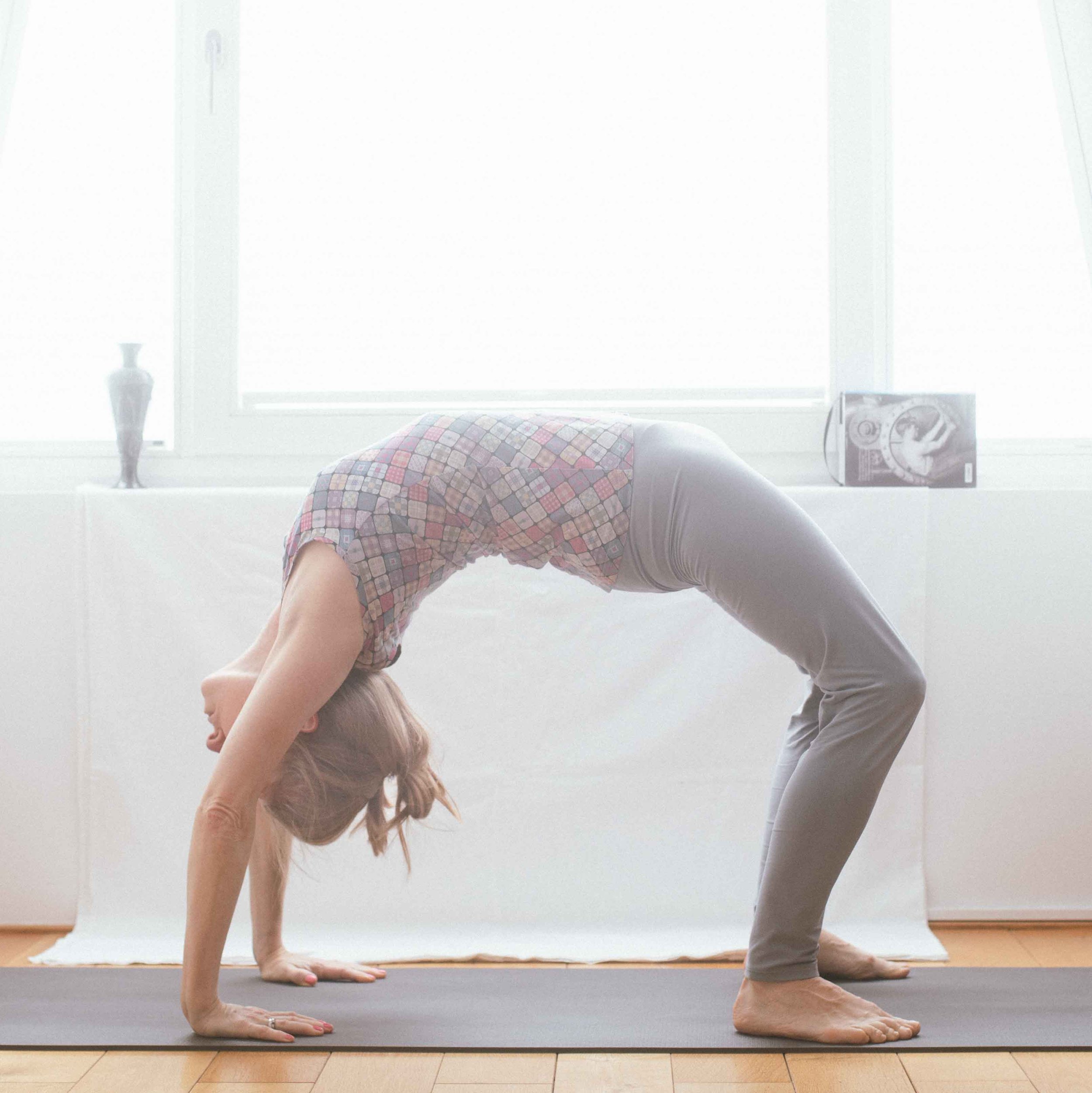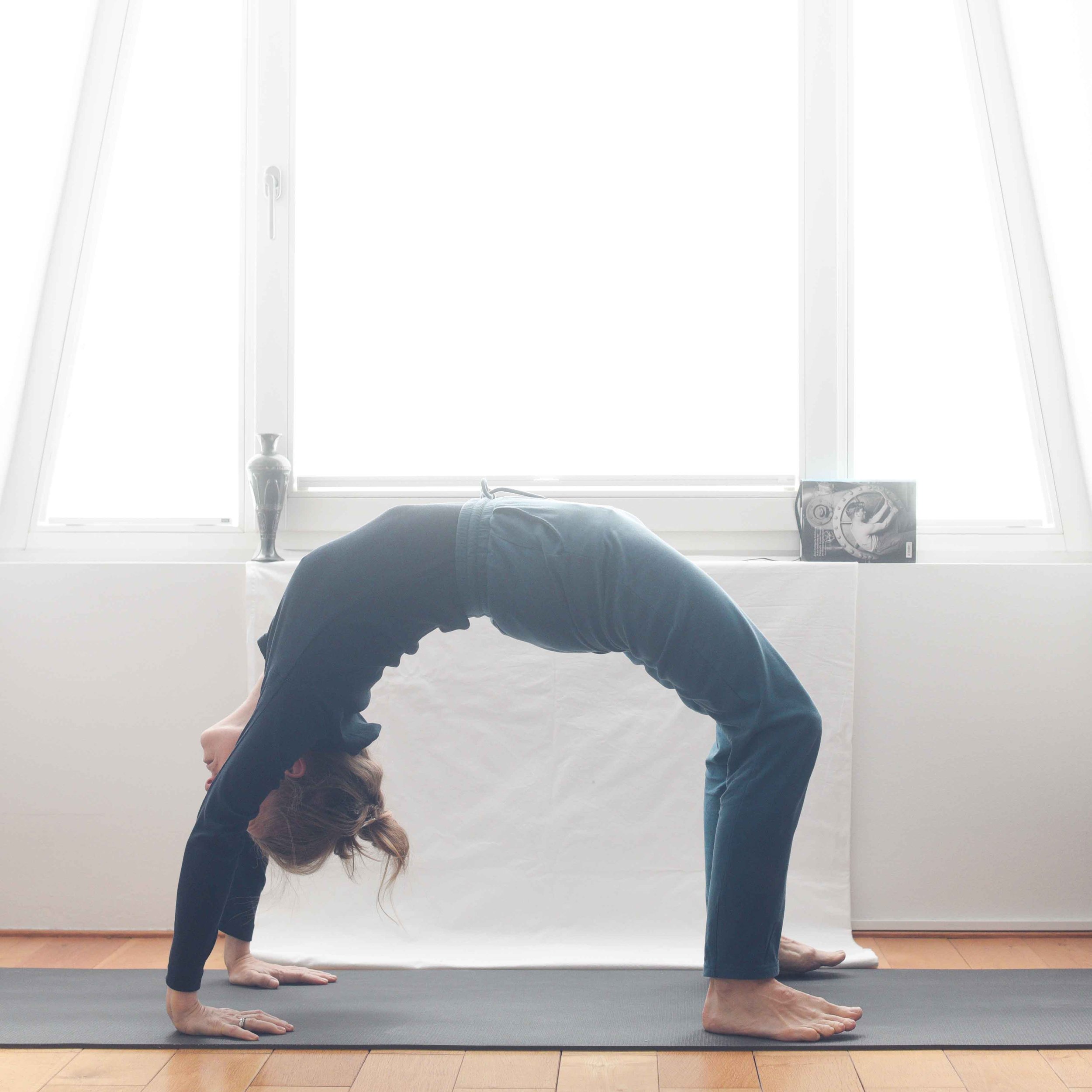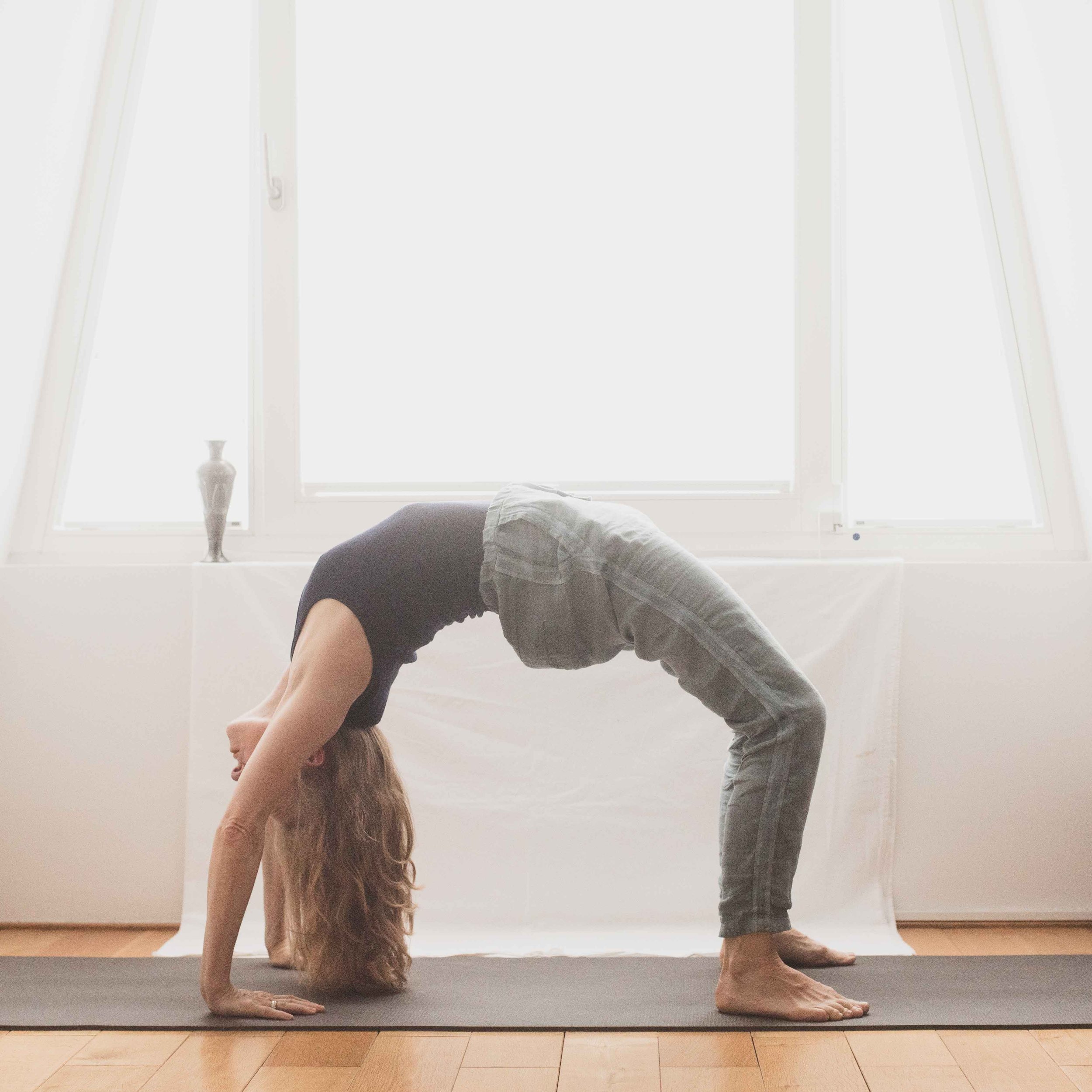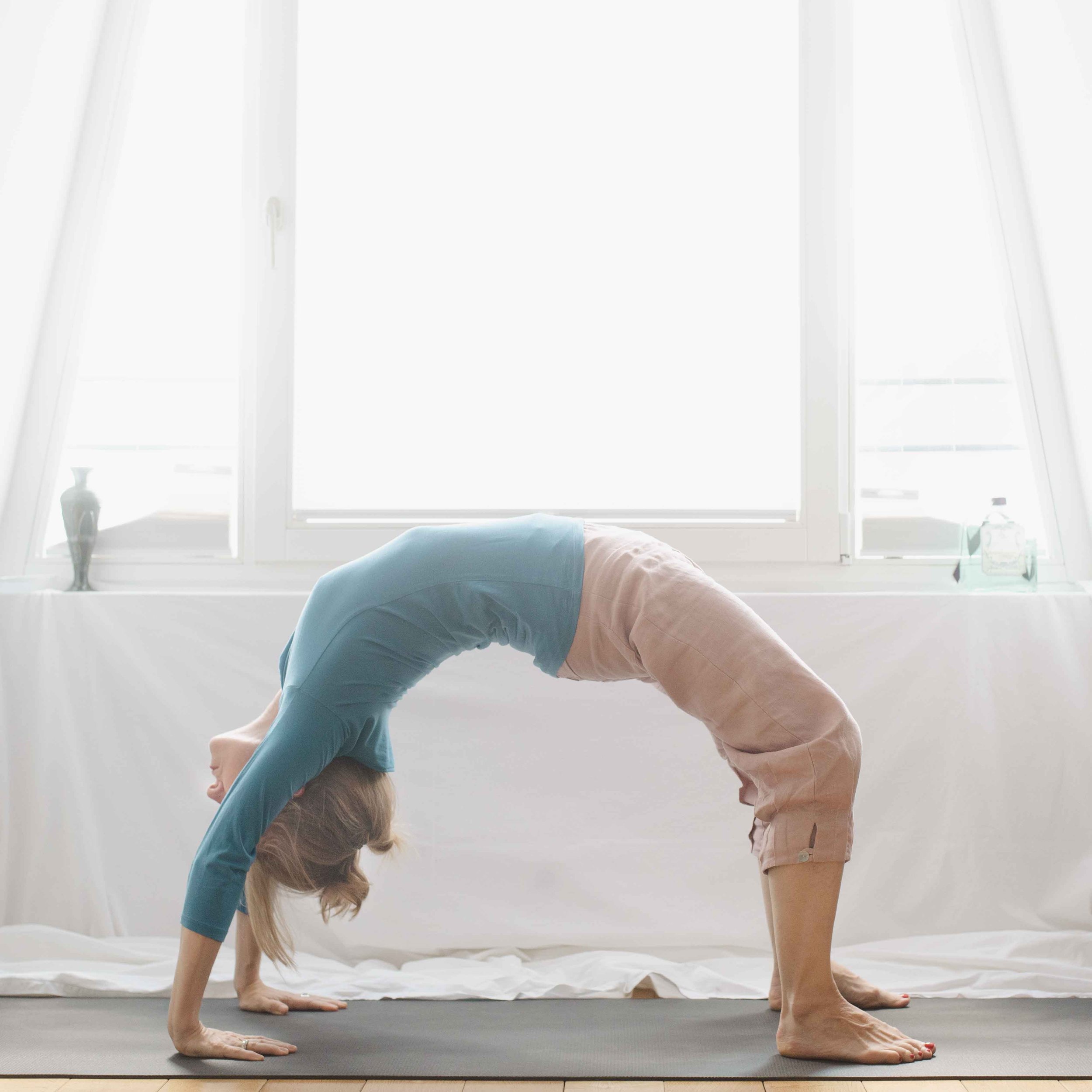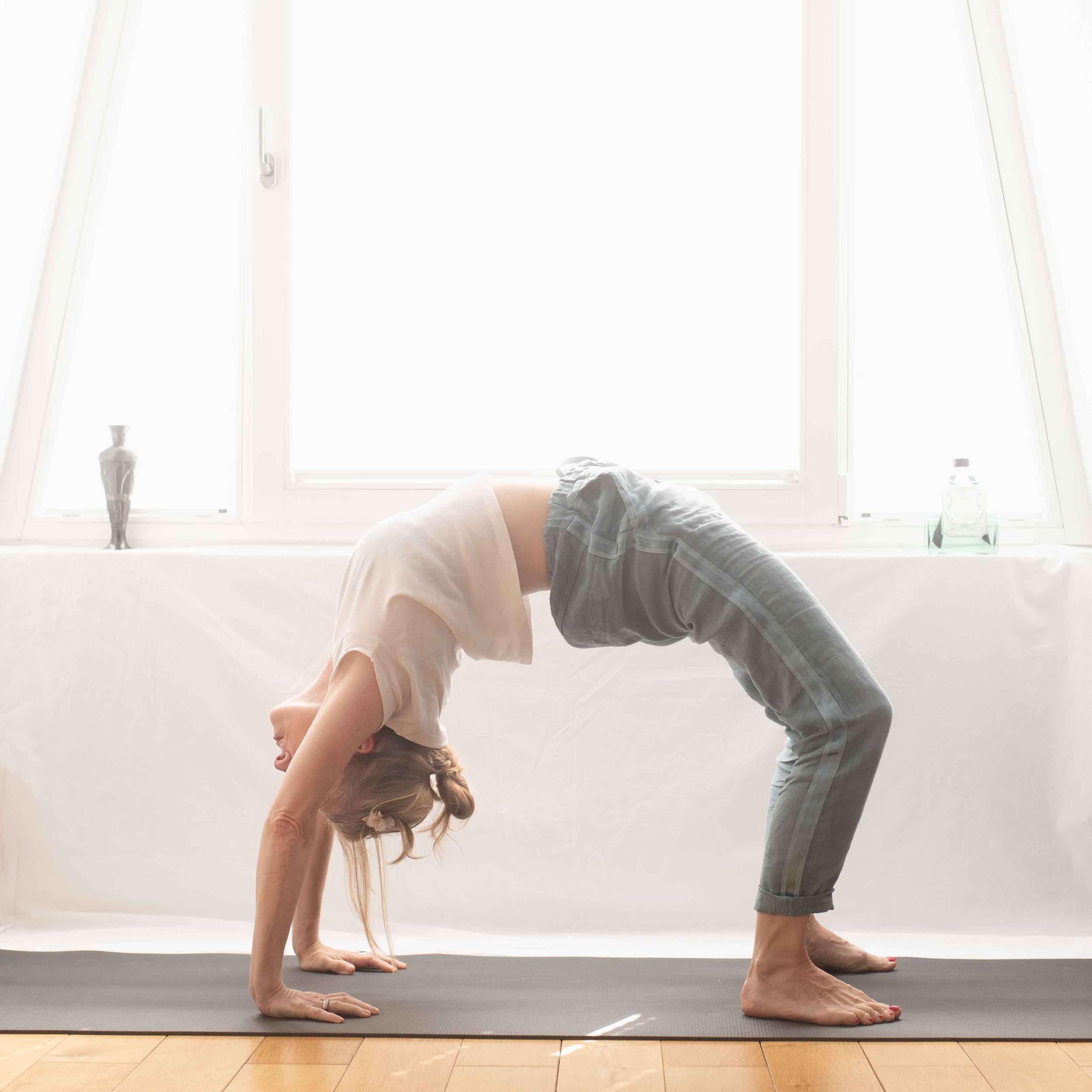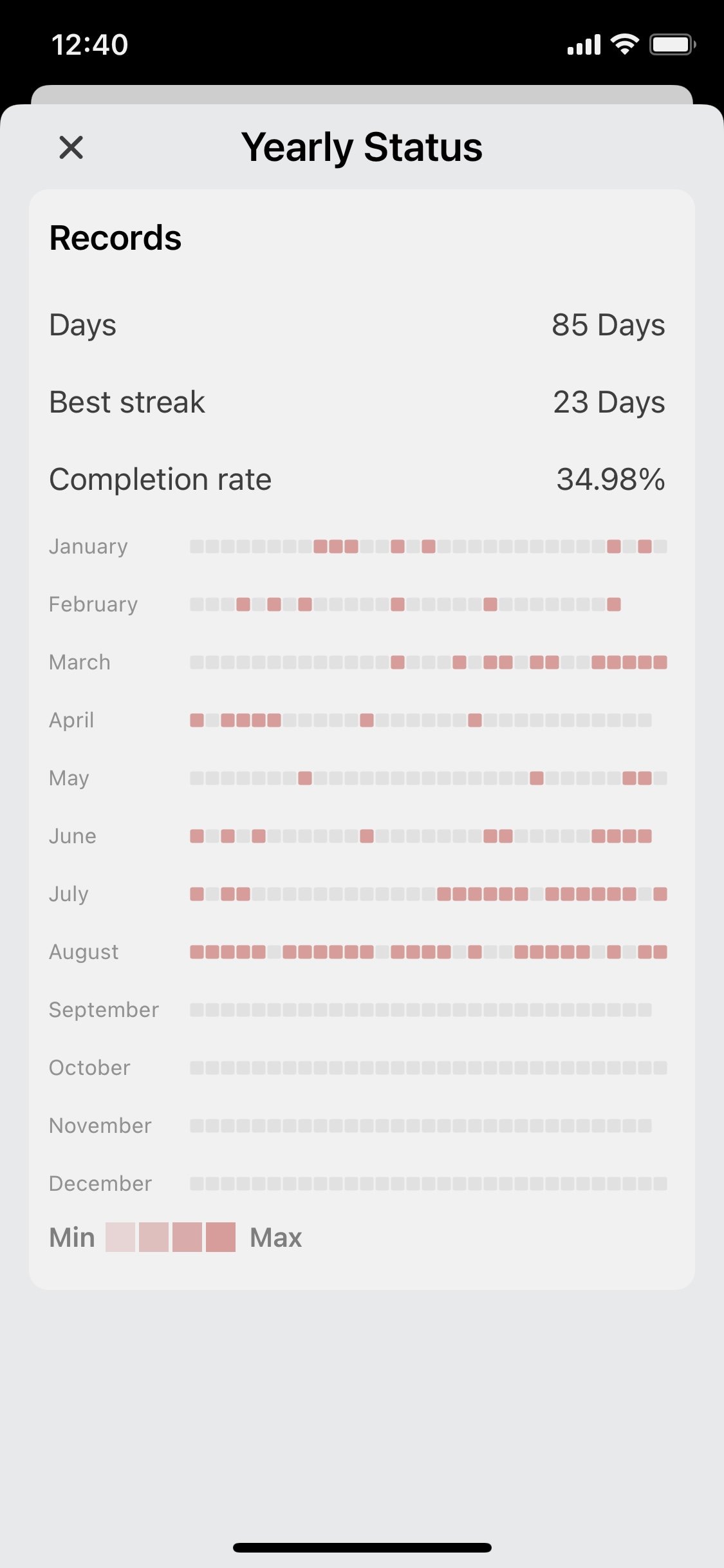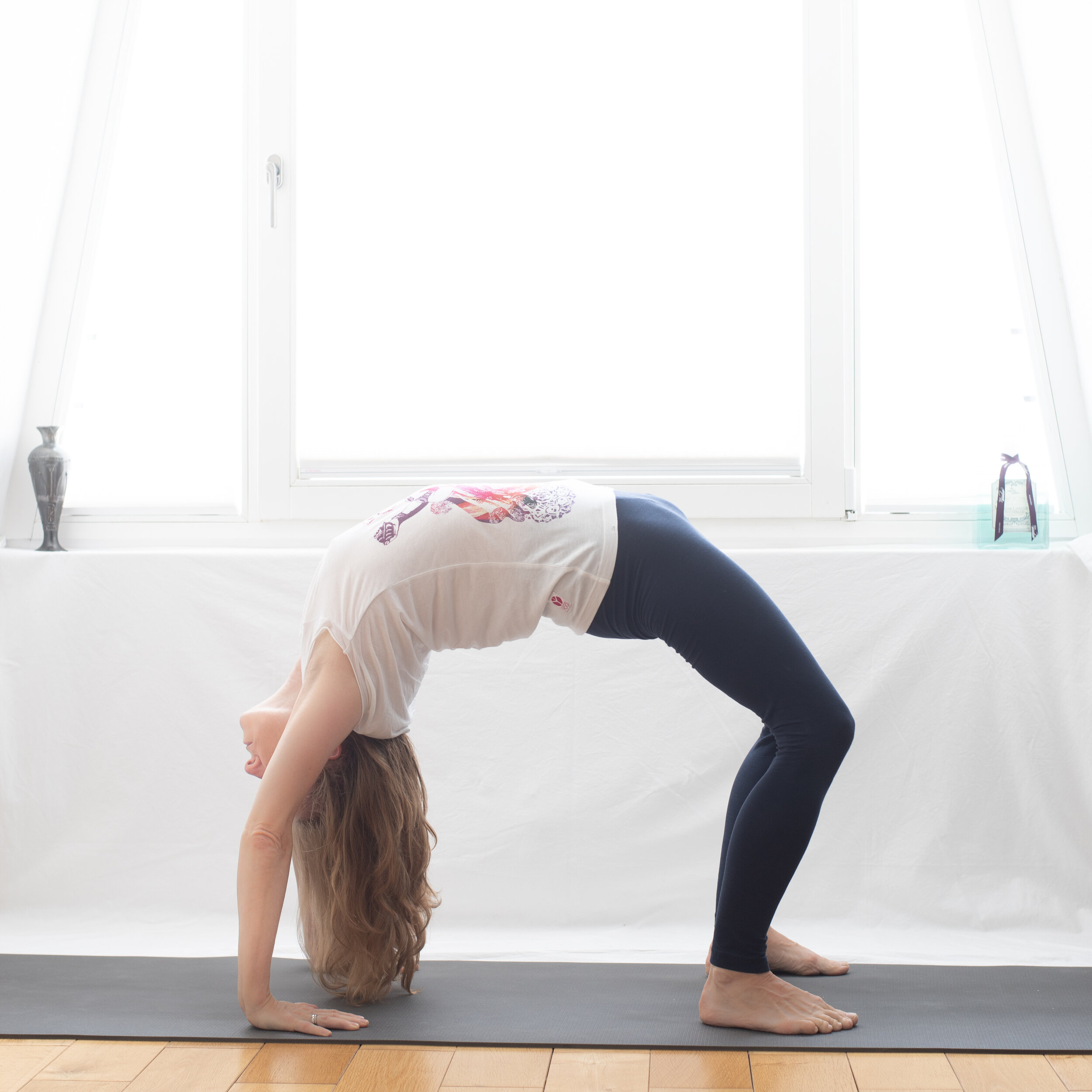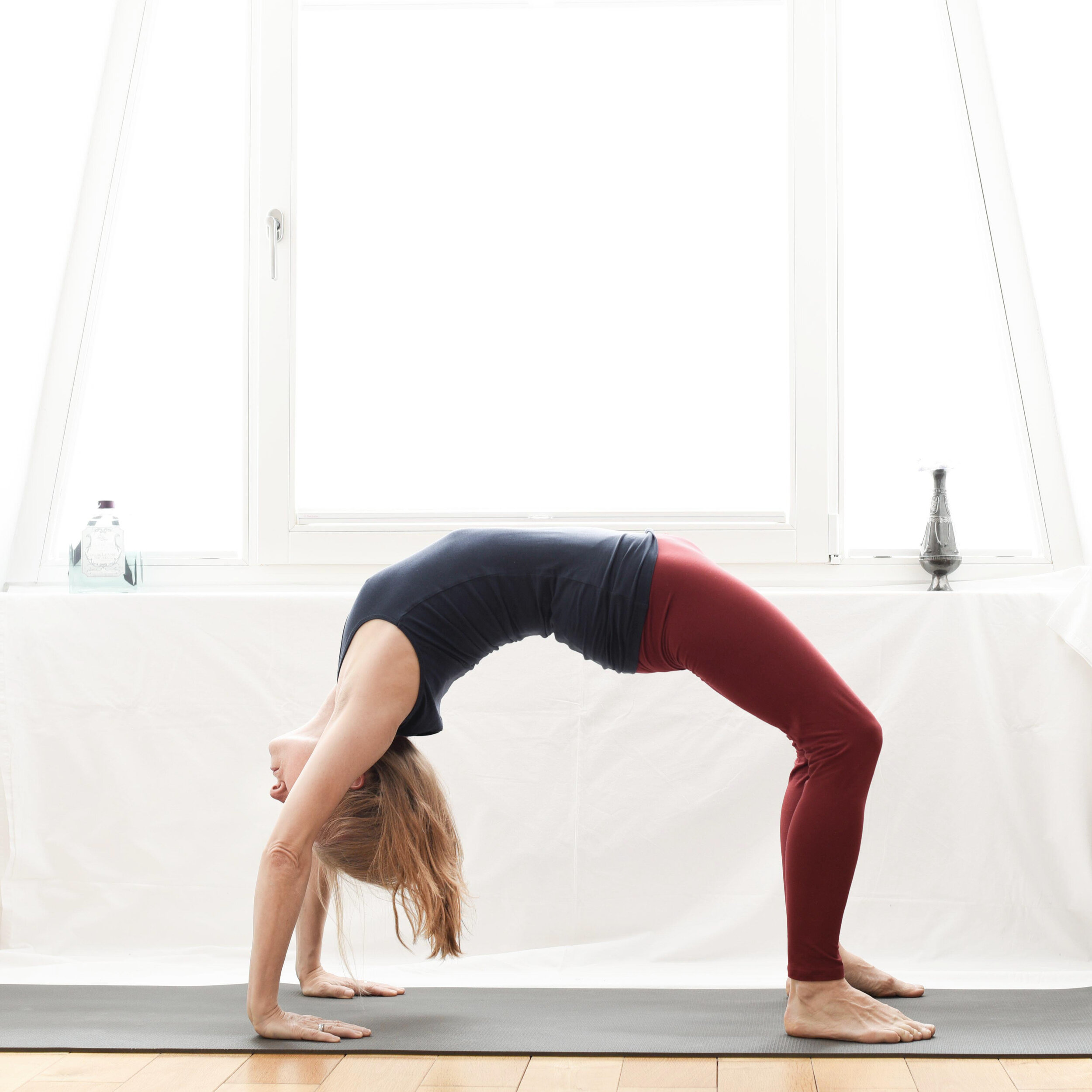Backbends: Pictures provide feedback
A new month begins. This reminded me that I wanted to see again whether my backbends have improved. There are so many aspects to backbends. Some have actually improved. Others I will have to and want to work on more intensively.
What has improved in urdhva dhanurasana is that the hands are closer to the feet than they were some time ago. My splits exercises, which stretch the hip flexors, are paying off. I was really happy about that today. There are only three and a half wooden planks between my hands and my feet. Hallelujah.
But I find it difficult to push myself up into the position. This has to do with strength again. I can work on this in February.
A good exercise for this is to push yourself up again and again, like with push-ups or squats, only differently. First I want to find out how many repetitions I can do and work from there. Three sets of the repetitions I can just manage and do them every day. What a great plan. Haha......And then I lie on my back tomorrow and want to push myself into urdhva dhanurasana and then I think 'oh no', 'how exhausting', 'I can't'. But I can go from this 'I can't' to 'I want to, I can'.
Then we'll see what the backbends look like at the end of February.
What has improved over the years is my concentration. I don't like to interrupt my practice by taking pictures. But pictures are the best feedback I know. I also need pictures for my blog post. They also motivate me and bring me a lot of joy. I have found a solution. I prepare everything before I start practicing. I roll out the second yoga mat where I can take the pictures. The camera is set up. I basically just have to pull the trigger. This makes it possible to take pictures without interrupting the exercise too much.
I have also found a remedy for my left hip. I always have Tiger Balsam from Singapore in my medicine cabinet. I spread the camphor generously on the inside of my left hip. I already noticed improvements today. Could that be? It was like this.
Keep practicing.
The perfection trap
Germany, December 2023, urdhva dhanurasana
My goal was and is to photograph the asanas of the four Ashtanga yoga series. Of course, you have to be able to perform these asanas first.
Well, I definitely wanted to get from urdhva dhanurasana to standing before I started photographing the 2nd series.
And I wanted to get the heels on the floor in pashasana before photographing this asana and then the next asanas. I also wanted to keep to the sequence.
I had set the bar so high that nothing happened in the end.
Who knows how long it will take me to get the heels in pashasana on the floor? At the moment, I'm happy when my fingers reach each other. I'm a long way from reaching the joint.
Coming into standing from urdhva dhanursana is very challenging. Who knows when I will succeed. In a month, in two years?
Next year I will change my approach to the goal of photographing the asanas in the Ashtanga yoga series. I will photograph the asanas that have reached a level that I am happy with. More is always possible. Then I will see which asanas remain. I can then devote myself particularly intensively to these hard chunks.
The journey then goes from easy to difficult.
Today I realized again how important it is to take pictures. They provide important clues as to the direction in which you can continue practicing. Taking pictures interrupts the flow. The focus is more on the pictures than on the exercise. But pictures are so helpful that I don't want to do without them. It's also super interesting to see the difference between feeling and reality.
Urdhva dhanurasana - an analysis
Urdhva dhanurasana, Germany, August 2023
I quite like what I see. The bridge is very symmetrical. I also manage to press myself straight into the position. The elbows are as good as stretched.
I also see that there is still potential.
- The hands could move even further to the feet or vice versa.
- The hips could be stretched further.
- The neck and also the upper body and also the shoulders could be stretched further.
This is immediately a plan. The individual body parts can be trained in isolation.
Strength is also needed. It happens to me again and again that I lie on my back and then think: Oh no, now push the entire body up, my goodness. I think it's because of the strength that's needed here, or rather the lack of strength. The position becomes easier when you are stronger. You can also think of the whole exercise as a strength exercise. You brace yourself against the normal straight posture.
In Callisthenics, the bridge is also an exercise. You keep pushing yourself into the position. The colleagues in the other gym see the position as a strength exercise first and foremost. For the yogis, everything is stretching first. You push yourself into the position over and over again.
One goal could be to aim for three sets of twelve repetitions.
So many ideas, and time just runs out.........
Back bending is the focus in September.
Arm and shoulder stretch, September 2022.
I don’t want to stop the process that has become so interesting lately. All the back bending asanas and exercises that I did during my morning practice last month helped me to find back bending less difficult. This cannot be seen dramatically, but I feel it. I feel much less resistance to bend backwards.
I found 2 excellent teacher who help me on my back bending journey: It’s Ugi on Omstars (this is her Instagram page) and Anmol Singh on YouTube. The videos that Ugi and Anmol produce are excellent. Both are super experienced. The sequences are well thought through. I get out of my routine that makes me feel stuck. I’m amazed how many exercises support the back bending journey. Trying new poses and routines raise the attention. I have the feeling I leap ahead. I’m happy with tiny steps as well.
Ugi and Anmol teach also very advanced asanas. It looks all easy when they do it. Yet some asanas are not doable for me. One can pause the video and exercise the asana several times. This. is one possibility. Repetition helps to get deeper into a pose and to understand it better. Nevertheless I also have to omit some very advanced asanas. To reach my feet with my hands when bending backwards won’t happen overnight, also not within a month. It’s important to stay creative. It’s not necessary to follow rigidly a sequence.
One must pick oneself up at the level that is comfortable. From there one can push forward. Tiny steps are great. These tiny improvements are underestimated. It adds up. Breaks ruin the progress. Keep practicing is easy said, but so important.
My development is slow, but steady. I also know set backs.
The pose in the picture stretches the shoulders and upper body. The fingers are interlocked, the palms face the ceiling. I move the arms backwards. A stretched upper body is necessary for a deep urdhva dhanurasana. It’s possible to repeat this little exercises whenever it crosses one’s mind.
My goal for September is to drop back again into urdhva dhanurasana. I’ll work on coming up to a standing position as well. Therefore the hands must walk closer to the feet. 🦶 A courageous goal.
A daily practice is the goal.
Before reading this blog post, I’d like to ask you which picture is taken the 1st August and which one the 31st of August? Resolution comes at the end of this blog post.
In August my goal #1 was to practice more freqeuntly. My habit app told me that I had an average practice rate of 28,77% at the end of July. . At the end of August my average practice rate is 34,98 %. It goes up slowly as I started using the app in the middle of last year. All the data are processed by the app to calculate the average rate. I didn’t really use the app in the beginning so the results are not accurate. This is not so important. The app helped me to see where I could improve. I practiced not often enough. I can see a development now.
I started using this app on a daily basis in the middle of July. August looks pretty good for me. It’s motivating to use this app and to see all the red dots. One red dot stands for 90 minute Ashtanga yoga. More important the app tells the truth (when used of course).
What do I record? I only record when I practice Ashtanga yoga in the morning. Last month I practiced several times in the late afternoon. It was not an Ashtanga yoga routine but sequences that focused on back bending. They were precious, perhaps they made the difference, but they are not recorded. I don’t care as I get an overview about my activities. .
A few times I didn’t practice in August:
I had an appointment at the dentist in the morning, I had a toothache. This is a reason not to practice and not an excuse.
Once I overslept. I had had time in the morning before this appointment at 9:30am, but time was too short then. In the evening I practiced, so that’s OK. I aim for flexibility not for rigidity. Routines are useful, but they are not written in stone.
Once I couldn’t convince myself to practice. It was impossible to get on the mat. I can live with this. I remember that I was ready for a yoga sequence in the evening.
When I reach 80% of my goals I consider this as very good. My observation: Those who are only content when ‘perfection’ is reached are much more discontent in life than those who are happy with 80%. Being discontent might free a lot of energy. Not liking a situation can give a lot of power to reach goals and to get out of an annoying situation. On the other hand with yoga we won’t win a medal. I take my practice rather seriously, but I usually don’t want to give it the power to make me feel bad. The opposite is the case. My practices better my life.
Lately I listened to an YouTube video with a very successful swimmer. He told the ambitious audience why he was so successful. 200 times every year he is not in the mood to swim, but he does it anyway. This was one of his success formula. Is this true, that most of the time he didn’t like to do what he was doing?
For me only the beginning of a yoga practice is hard, then I like my practice. Of course I can take it easy. I don’t have to practice. It’s not my profession, I don’t have to win medals either. Nevertheless if I had to force myself 200 times a year to do what I ‘want’ to do I questioned if this is the right activity that I was doing.
Perhaps talent limits his decision. Perhaps lack of alternatives forces someone to do something that he doesn’t like to do?
It’s surely true that we’re not every day in the mood to do what we want to do. To let the moods make a decision is not a good advice. One could miss a good practice. Moods change all the time. Some people are more moody than others. Some people have acquired the skill to be disciplined. They do what needs to be done. Point.
Also in September I’ll focus on the frequency of my practice. I’ll keep focusing on back bending.
Picture: The second picture is taken at the end of August. I’m glad that it’s visible that I practiced a lot and intensively. Yesterday I checked both pictures, yet they were not next to each other. I was disappointed and thought that all the effort was in vain. It wasn’t. I can see a difference when the pictures are next to each other. Halleluja. The show can go on.
Urdhva dhanurasana
Urdhva dhanurasana, August 2022
I don’t know when I dropped back the last time. I stretch the hip flexors, the shoulders, the upper body. I hold urdhva dhanurasana for 1 minute. I drop against a wall. I do a lot of additional exercises to improve back bending in general. Yet I avoided to drop back. I felt too stiff and I didn’t care so much.
Nevertheless soon I’ll drop back again. I feel ready again. It’s always a test of courage. Important is to stretch the arms against the floor as soon as the falling backwards begins.
Today was my second practice of this week. Yesterday was lousy. Today was fantastic. That’s how it is. A flexible practice doesn’t mean that the next practices will be even more flexible. This projection will get disappointed.
A stiff and weak practice doesn’t mean that a setback is experienced.
There are ups and downs like in life. The importance is not the quality of a practice, rather that it’s done and the energy and concentration that one was able to put into the practice.
How to get into urdhva dhanurasana?
A decade ago I put my hands next to my ears. Then I lifted my body up. The weight shifted to the feet and then back to the hands. I pressed the feet against the floor to move the weight to the hands.
I learned a more sytematic approach. Often there are different ways to get into an asana. Re urdhva dhanurasana I work also on another vinyasa. I want to learn again to drop back from a standing position. Some people get from handstand into this pose.
When I went to the Sivananda yoga classes years ago we practiced first salamba sarvangasana. From there we lowered the feet to the floor. Then we pushed up into urdhva dhanursana, bow pose. This vinyasa allowed me to get rather deep into the pose.
Every vinyasa is different, feels different and has different challenges.
The pictures in the gallery show my countdown into the pose from lying on the floor:
I start from lying on my back und pull the feet to the body. Arms lie next to the body.
Then I lift up the hips. The arms can support this movement when pressing into the floor.
The next step is to pose the hands next to the ears. Important is to keep the elbows close to each other. Arms remain parallel.
Then the hands and arms press into the floor, the arms stretch slightly, and give room so that I can set the crown of my head on the floor. Sometimes I omit this step and I get at once into urdhva dhanurasana.
Last step is to lift up the body. This requires strength and the ability to stretch the arms. These days I take care not swing forward and backward. I want to lift up the body straight towards the ceiling. The weight is evenly on the feet and hands. It feels as if more weight is on the hands. The goal is to have en even bow. Feet and hands get closer and closer with time and patience.
A useful exercise:
In order to stretch the body and to get used to this asana I hold it for 1 minute every day. I use a timer. This little exercise shall make me stronger as well. 1 minute feels very long. I focus on the breath to distract myself from the discomfort. Today I realised already that it became easier to hold this pose. In the beginning I was not able to hold it 1 min. Progress came quickly.
Three possibilities to get into urdhva dhanursana (there are more):
from a lying position.
from a standing position.
from salamba sarvangasana.
Keep practicing.
Urdhva dhanurasana - back bending
Urdhva dhanurasana, August 2022
The bow looks good, it’s rather even. The hands are too far away from the feet. This makes it impossible to come up from this asana. That’s why urdhva dhanurasana is the focus in August. Yet, the arms are nicely stretched. The pose looks balanced and easy. Everything must look easy these days, even though it isn’t.
Oh, did I forget goal #1? Of Course not. I want to ramp up the frequency of my practice. Only when I practice yoga asana can improve. The time spent on the mat needs contents and focus.
Most of the time I practice second series till after the twists. I add so many asanas that time passes by too quickly. There is no time to do the entire second series within 90 minutes. Might be that I’ll limit all the additional asanas one day again. Right now it feels good. Bending backwards is no more such a horror idea. I think all the easier back bending asanas that I practiced before the more challenging ones made the approach to back bending more joyful.
I practice urdhva dhanurasana after my attempts to do kapotasana.
My most important exercise right now is that I hold urdhva dhanurasana 1 min. I use timer and I count my breaths. I need much more breaths than in a relaxing position. To focus on the breath distracts me from the discomfort that sets in after a while. One minute is not long, but it feels long.
Those who practice Ashtanga yoga know the urdhva dhanurasana sequence. After 5 breaths one lowers the head to the floor, the hands walk closer to the feet and then one lifts up the body again. This is done twice, so that urdhva dhanurasana is done three times in total. At the end one shall be able to stand up from this position. Not possible yet, that’s why I want to focus on that pose.
This routine frustrates many yogis. It’s integrated rather late in the primary series. It pops out as something that doesn’t belong at that place. After all the forward bending asana of primary such a deep back bending pose is neither logic, nor does it feel good. Most yogis struggle with this routine. I guess that many give up.
Life is not logical either. I feel ready to work again more intensively on that asana. I’m curious what is possible within a month.
Urdhva dhanurasana - a detailed approach
Urdhva dhanurasana, June 2021
This is how my urdhva ddhanurasana looks these days. It’s visible that I worked on back bending.
My understanding about back bending deepened. It allowed me to work with different body parts separately.
The leg muscles need to be strong in order to come out of the pose. Equally important is to stretch them.
Most of us have a sedentary life. Many Ashtanga practitioners practice primary for years these days. The hip flexor is shortened therefore. This makes back bending difficult. To stretch the hip flexor takes time, it comes with discomfort. Yet finally flexibility can improve. In order to stretch the hip flexors I add exercises during my practice. I work on the splits every day as well.
The entire body can get lengthened if one hangs over a high chair so that feet and hands are in the air. One can also hang at a bar.
To stretch the shoulders and upper body made a huge difference for my back bending ablilities.
The arms need to be strong in order to lift up the body. Isolated strength training can be done.
It’s also important to get into the pose correctly.
Deep breathing supports the movement.
A goal is to feel good when performing an asana. To stretch and to work on strength comes with discomfort. Otherwise nothing happens. Yet finally an asana can bring joy. It can be possible to relax in an awkward looking position. Sometimes I reach this status, sometimes not. Often an asana feels better at the second and third attempt. Not to give up too early can be rewarding.
My yoga week has started. The first surya namaskars is always a bit stiff, but soon the body woke up.
Explore your possibilities.
Life is an experiment. Be courageous.
Urdhva dhanurasana
Great. I did it.
Today was my back bending day. I usually start with the second Ashtanga Yoga series on Sundays, Tuesdays and Thursdays. I add asanas that I consider as supportive. For instance do I add the splits before ustrasana. Today I stretched also the upper body. Usually I practice urdhva dhanurasana against a wall. I hold it for one minute. These tiny variations make it easy to repeat the pose. Repetition is so important. Often the back bending asanas take so much time that I don’t have the time to do all the poses of the second series. I usually add twists and one or two forwardbending asanas. A longer or shorter closing sequence finishes my practice. Tomorrow I’ll work on forward bending asanas and vinyasa again.
The floor on the picture tells me that my hands couldn’t walk closer to the feet since I took pictures the last time. The pose looks like a few weeks back. This is OK, because practicing this pose is already an accomplishment. The pictures are so similar, that I wonder what is different. This time I had put my T-shirt into my pants to prevent it from sliding. I used the black yoga mat as it is thicker and softer.
Hard work shows results.
Urdhva dhanurasana June 2020
I had a clear goal in mind. Feet and hands should get closer to each other. Last time four boards were between hands and feet. I got closer. To have only 3 boards between hands and feet was the goal. I’m not yet there, but I’m closer. This astonished me when I checked my pictures. I thought it would take longer to minimize the distance between hands and feet.
I did stretching exercises for the hips (lunges).
I did additional stretching exercises for the upper body and the shoulders (hangman i.e.) This allowed me to get deeper into this back bending asana.
I usually hold this pose for one minute. I start a timer. It’s still a challenge and I’m always close to give up. But I hold it. This stretches the body. The body gets familiar with the asana.
Most important is to practice safely. I always try to get safe into this pose:
I start from lying on my back. I bring the feet as close to the body as possible. Feet shall be parallel to each other. It feels as if they are turned inwardly. The pictures proofs that the feet are rather parallel.
I put the hands under my shoulders.
The next step is important. I press the back on the floor. This causes a movement of the hips, that prepares for the back bending. I engage the bandhas to protect at least the SI joints.
Then I lift the body up, till the crown of my head is on the floor.
With the next inhaling I get into the pose. I try to keep the elbows parallel. I also try to get into the pose without moving to the feet and then swinging back. It’s recommended to get straight into this pose.
Finally I adjust. In order to have an even bridge I push the body to the hands with my feet.
I breathe deeply. After a while I walk the hands closer till I reach my limit.
Those who experienced injuries especially back injuries know that it’s important to practice correctly. Strong legs are important, strong arms, too. A strong core is useful, too. Yet it’s recommended to create length in order to bend. This allows to relax the lower back.
This picture is taken after many many back bends. I was prepared for this asana. It’s summer here, it got warmer. Warm weather is such a support for the practice.
The process is volatile
Not one single practice is like another one.
On Sundays (today) my yoga week begins. My arm was still a bit warm and hardened due to the vaccination, but I could practice. After a break of three days I felt stiff. The practice today was a warm-up. My approach was rather easy-going than ambitious. Only one thing I wanted to do and I did it. I held urdhva dhanurasana for one minute. It was hard, but I could feel that it’s going to be easier. Two weeks ago I couldn’t hold this position so long. When it gets tough, I start counting. After 15 breaths I walk my hands a tiny bit closer to the feet. It distracts me from the thought that I cannot hold this pose for another fraction of a second. I know, I can. After 5 more breaths the minute is over. The sound of the timer is impatiently awaited already.
More important than having practices that are mega, is to practice. This stiff practice today is the basis for the good ones to come. One must love the process. The process is volatile. It comes with many different feelings. They range from joy to frustration.
Ups and downs are part of life, too. Some days are excellent others not. Sometimes we blame people and things for our days, but this doesn’t help much. On the mat we learn to stay relaxed. I keep breathing when I feel discomfort. I keep breathing when I get frustrated. I keep breathing when things go well. Breathing is always possible. Observing is possible, too. These are methods that can also help us during difficult times.
One practice out of 6 is done already. This gives me confidence that I’ll practice tomorrow as well.
It’s going to be a nice day with a lot of sunshine.
Know the why
If one knows the why it’s easier to do anything. An activity becomes an urgency. It can give huge energy if one can better the own life. It can be even more rewarding if the reason why we do something are other people or animals.
I know why I practice yoga. I feel better every day after my practice. Yoga gives an orientation in my life. My yoga practice will support my goal to stay as long as possible independent from support. I know many reasons why I practice yoga. To know one reason is enough. But this one reason must remembered when it gets difficult to exercise. Valleys always come for everybody no matter how experienced a yogi is. To have no issues anymore is not the promise yoga gives.
Reasons for our activities are endless. We might go to work because otherwise we get fired or we cannot survive. During Corona times I wear a mask because the grocery stores don’t let me enter. I also don’t want to be a danger for anybody. In addition I have to pay a fine. Not always the reasons for an activity are convincing. Sometimes they are not strong enough to make a person doing anything.
Today I also realized how important it is to practice early in the morning. It’s good to practice before breakfast, but it’s better to start really early, let’s say 6:30. Today I started at 8 am. The world wakes up already. In the neighborhood the craftsmen start working. This is always loud. Cars can be heard. The telephone rings. My beloved E gets up, takes a shower and soon I have the smell of coffee in my nose. Suddenly I was in a hurry. I was in the middle of my practice. I finished it gracefully. The feeling of calmness, having time, being relaxed is better than feeling in a hurry. I hope this experience of today gives me a good reason fro tomorrow morning to get up and to leave my cosy bed.
My most important task today:
I’ll write a handwritten letter to a very nice seven year old boy. Also the youngsters must learn at home. It’s difficult to learn writing by hand if you have a PC and if it’s possible to type. One day it might not even be necessary to know how to write our own name. We can use our fingerprint. Nevertheless the schedule forces this smart little boy to learn writing. Why? He might not see a good reason. Tomorrow he’ll get a letter written by me, with some questions. Yesterday I bought a nice card in addition. I’ll express my joy if I get an answer. A return letter will be in my letter as well. I don’t want to create obstacles. I hope that my letter will give him a reason to learn writing by hand. It’s so much more joyful to have a positive reason than to be forced to do something. I know that I’m rather self-confident when I think that I’m a good reason to learn writing.
Elbows in
Yesterday I saw a very interesting Youtube video on urdhva dhanurasana. It’s possible to stretch different body parts isolated. The yogi even recommended to stretch for 5 minutes. Stretching takes time. To move in a pose and to leave it after 5 breaths is not enough to stretch effectively
There are two parts of the body that one can stretch as a preparation for urdhva dhanurasana. It’s the front of the hips and the upper body. I usually stretch the front of the hips with split poses. There are a lot of stretching exercises for the upper body. On the picture is one of them.
The most interesting tips came at the end of the video.
The elbows shall move inwards. They tend to move outwards. I checked my video and realized that this is the case when I lift up into urdhva dhanurasana.
The next tip is to move forward when lifting, not upwards. This avoids that the body moves back and forth till the end position is reached.
I tried to implement these tips today. It felt good, not only because it’s demanding. It also seems to be the correct movement.
Learning never stops. The worldwide yoga community has so much knowledge. Sometimes it’s difficult to find the good voices, but it’s possible.
Highlight of my practice today:
More and more asana are easy to perform when I practice primary. The body has a good memory. I have the feeling that I could take a nap while performing many asanas. This is of course not possible, as each and every asana needs attention. Some muscles are active, some relax. The bandhas are engaged and the eyes are open. Feeling good is the goal, it’s as if one has reached the top of a mountain. It allows to look back to the stony journey. Joy arises.
Each practice gives me ideas for the next practice. Tomorrow I’d like to use a strap around my arms to keep the elbows in. The body should be able to have the strength and flexibility to do this alone. The strap can only help to give the feeling. Despite the strap the elbows should move inward not outwards. If the strap is sliding it’s a good sign that the body has understood the movement. All tools should only be used temporarily.
Back bending
Yesterday was a day off from yoga. The body needs this day. I slept a lot and was lazy. After only one day the body is already a tiny bit less flexible. Yet I felt strong. I was yearning for my practice. The body felt fresh and relaxed. I was motivated.
Again I realized how important it is to focus on one topic. Today it was back bending. The one and only goal for this week is to hold urdhva dhanurasana (UD) for 1 minute and 20 sec. I need these 20 sec to switch on the timer and to get into the pose. Today I could hold UD already a few sec longer than last week. I’ll aim for 25 breaths. Then the alarm should tell me that it’s done. My breaths is faster than in relaxing positions. The average number of breaths within a minute is 15. Yet if a position is exhausting the body meeds more oxygen that is more breaths.
When I practice I don’t take pictures these days, because I want to focus on the practice. Taking pictures is motivating, but also distracting. The above picture is taken after my yoga practice. I experimented. Imagine: Some yogini can reach the head with their feet. No joke. I don’t think that this position will support my back bending goals in general. Nice to have tried it out.
The wheel an be a useful prop. Not every position over this wheel makes sense.
The yoga week has started. I’m looking forward to the coming week.
Urdhva Dhanurasana
Yesterday I went to a yoga class again. The teacher led us also through more challenging asanas. When we were in urdhva dhanurasana we were asked to lift up the right leg, then the left leg, then the right arm, then the left arm. I was more than surprised that I could do this. This variation was lost. Now it’s back. This is so awesome.
It was not a piece of cake.
Lift the leg, I thought. There was no alternative to this message. And voilà.
I don’t want to give up my home practice anymore. Yet yesterday I also saw the advantages of yoga classes. I got introduced to variations of asanas that I’ve never practiced so far. To practice in a group is fun and it gives energy.
I bought a membership at the Sivananda yoga studio. It lasts one year. It shall complement my Ashtanga yoga practice at home.
I’ll write about my Sivananda classes more in the next posts.
Wheel every Wednesday
Another Wednesday has come. I took a picture of another wheel (urdhva dhanursanana). Today I took the picture after primary Ashtanga yoga series with all these forward bending asanas. To get from forward bending asanas to back bending asanas rather quickly without much preparation is an extra challenge. But sometimes I take this Wednesday wheel after many back bending asanas. When I compare all these wheels I cannot make out a difference. I should change my yoga clothes…. hahaha…….but brighter colors are better for the pictures.
I call this a plateau. On the surface nothing moves. Yet it requires discipline not to give up. One day it might seem like a miracle a difference can be seen. It might seem as if progress happened from one day to the next but this is not true. All the effort, sometimes over months/years is necessary. Perhaps I’m stronger again and the flexibility got weaker. Who knows……..
I keep wheeling. I love the community on Instagram. Worldwide are yoga practitioners who get into a wheel every Wednesday. This has power. This is amazing.
The gap between the plan and the performance
Sometimes there is a gap between the plan and what happens on the mat. A plan can only be a guide. It’s not written in stone. My plan today was to do 3 sets with 5 repetitions of urdhva dhanurasana. In addition I wanted to hold urdhva dhanurasana at least once for 1 minute. This was simply not what my body could do today. The idea to work on strength is surely good. It’s also good to hold the body longer in order to give the body time to stretch into the pose. The insight is that I have to create a training that picks me up where I’m now and not where I want to be . To create tiny steps are a good strategy. Tomorrow I plan to do 3 sets with 2 repetitions of urdhva dhanurasana. This is much less. I also want to hold this pose for 1 minute.
In many yoga classes I saw yogis before urdhva dhanurasana lying on the back, waiting. To lift up into urdhva dhanurasana seemed so heavy. I observed myself doing the same. I lied there, I knew what I wanted to do, but it seemed undoable. I think I know now why this was so. To lift up into urdhva dhanurasana required strength. I was not strong enough and at the end of a practice my willpower was exhausted, too. This is why I want to focus also on strength these days.
Strength: To get with an inhale into urdhva dhanurasana and to get out with the exhaling and to repeat this several times is more or less a strength training. The arms and legs are challenged.
Flexibility: Staying in urdhva dhanurasana for a longer time (1 minute or 2 minutes) and walking the arms to the feet or the other way round is a stretching exercise.
Both is needed. Urdhva dhanurasana requires strength and flexibility. One can work on both skills separately as described above.
Also the right technique plays an important role. The hips shall support the movement. A deep inhaling helps enormously to get into the pose. To create length in the body is also very important.
The wall is my favorite prop when I work on urdhva dhanurasana. It gives me orientation when I lift myself up from the floor. The upper body moves towards the wall. I also drop back against the wall from a standing position. One day I’ll surely drop back again in the middle of the room. It’s not the time yet for this dynamic movement.
Progress can be felt.
The final goal is that it’s relaxing and joyful to perform this back bending asana. I’ve been there.
Back bending
Today I was curious how the back bending asanas would look. They always feel intensive. What I realize is that I have a starting point that is motivating. Not everything is lost. The above pose was possible after many many repetitions. Today was my back bending day. Also my wheel helped me to get deeper and deeper into back bending poses. 90 minutes were over very fast. 90 minutes is enough. I try to fill this time with exercises that make sense. Quality over quantity.
The plan:
The classic exercise is to lift up and to hold urdhva dhanurasna for 5 breaths. Then one lowers the head to the floor. The hands walk to the feet. and again the arms stretch and lift the body into urdhva dhanurasana. I think this is a good start.
In order to get stronger one can lift up as often as possible. One can do 3 sets of this.
It can also be useful to aim for holding this pose for 1 minute. The body needs time to stretch. Last but not least urdhva dhanurasana is a pose that stretches the body backwards.
Urdhva dhanurasana is an asana that Ashtangis practice every day.
After the twists of the second series the time was over.

